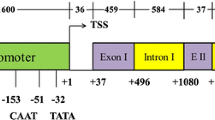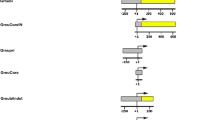Abstract
A polyubiquitin promoter (GUBQ1) including its 5′UTR and intron was isolated from the floral monocot Gladiolus because high levels of expression could not be obtained using publicly available promoters isolated from either cereals or dicots. Sequencing of the promoter revealed highly conserved 5′ and 3′ intron splicing sites for the 1.234 kb intron. The coding sequence of the first two ubiquitin genes showed the highest homology (87 and 86%, respectively) to the ubiquitin genes of Nicotiana tabacum and Oryza sativa RUBQ2. Transient expression following gene gun bombardment showed that relative levels of GUS activity with the GUBQ1 promoter were comparable to the CaMV 35S promoter in gladiolus, tobacco, rose, rice, and the floral monocot freesia. The highest levels of GUS expression with GUBQ1 were attained with Gladiolus. The full-length GUBQ1 promoter including 5′UTR and intron were necessary for maximum GUS expression in Gladiolus. The relative GUS activity for the promoter only was 9%, and the activity for the promoter with 5′UTR and 399 bp of the full-length 1.234 kb intron was 41%. Arabidopsis plants transformed with uidA under GUBQ1 showed moderate GUS expression throughout young leaves and in the vasculature of older leaves. The highest levels of transient GUS expression in Gladiolus have been achieved using the GUBQ1 promoter. This promoter should be useful for genetic engineering of disease resistance in Gladiolus, rose, and freesia, where high levels of gene expression are important.



Similar content being viewed by others
References
Bechtold N, Pelletier G (1998) In planta Agrobacterium-mediated transformation of adult Arabidopsis thaliana plants by vacuum infiltration. Methods Mol Biol 82:259–266
Binet MN, Weil JH, Tessier LH (1991) Structure and expression of sunflower ubiquitin genes. Plant Mol Biol 17:395–407
Callis J, Raasch JA, Vierstra RD (1990) Ubiquitin extension proteins of Arabidopsis thaliana: structure, localization, and expression of their promoters in transgenic tobacco. J Biol Chem 21:12486–12493
Castillon J, Kamo K (2002) Maturation and conversion of somatic embryos of three genetically diverse rose cultivars. Hort Sci 37:973–977
Chase M (2004) Monocot relationships: an overview. Am J Bot 91:1645–1655
Christensen AH, Sharrock RA, Quail PH (1992) Maize polyubiquitin genes: structure, thermal perturbation of expression and transcript splicing, and promoter activity following transfer to protoplasts by electroporation. Plant Mol Biol 18:675–689
Chu CC, Wang CC, Sun CS, Hsu C, Yin KC, Chu CY (1975) Establishment of an efficient medium for anther culture of rice through comparative experiments on the nitrogen sources. Sci Sin 18:659–668
Dellaporta SL, Wood J, Hicks JB (1983) A plant DNA minipreparation: version II. Plant Mol Biol Rep 1:19–21
Eady CC, Lister CE, Suo Y, Schaper D (1996) Transient expression of uidA constructs in in vitro onion (Allium cepa L.) cultures following particle bombardment and Agrobacterium-mediated DNA delivery. Plant Cell Rep 15:958–962
Gallo-Meagher M, Irvine JE (1993) Effects of tissue type and promoter strength on transient GUS expression in sugarcane following particle bombardment. Plant Cell Rep 12:666–670
Garbarino JE, Oosumi T, Belknap WR (1995) Isolation of a polyubiquitin promoter and its expression in transgenic potato plants. Plant Physiol 109:1371–1378
Garbarino JE, Belknap WR (1994) Use of ubiquitin promoters for transgene expression in potato. In: Belknap WR, Vayda ME, Park WD (eds) Molecular and cellular biology of the potato, 2nd edn. CAB International, Wallingford, UK, pp 173–185
Genschik P, Marbach J, Uze M, Feuerman M, Plesse B, Fleck J (1994) Structure and promoter activity of a stress and developmentally regulated polyubiquitin-encoding gene of Nicotiana tabacum. Gene 148:195–203
Goodall GJ, Filipowicz W (1991) Different effects of intron nucleotide composition and secondary structure on pre-mRNA splicing in monocot and dicot plants. EMBO J 10:2635–2644
Jefferson RA, Kavanagh TA, Bevan MW (1987) GUS fusions: β-glucuronidase as a sensitive and versatile gene fusion marker in higher plants. EMBO J 6:3901–3907
Kamo K, Blowers A, Smith F, Van Eck J, Lawson R (1995) Stable transformation of Gladiolus using suspension cells and callus. J Am Hortic Sci 120:347–352
Kamo K, Blowers A (1999) Tissue specificity and expression level of gusA under rolD, mannopine synthase and translation elongation factor 1 subunit α promoters in transgenic Gladiolus plants. Plant Cell Rep 18:809–815
Kamo K, Blowers A, McElroy D (2000) Effect of the cauliflower mosaic virus 35S, actin, and ubiquitin promoters on uidA expression from a bar-uidA fusion gene in transgenic Gladiolus plants. In Vitro Cell Dev Biol Plant 36:13–20
Kawalleck P, Somssich IE, Feldbrugge M, Hahlbrock K, Weisshaar B (1993) Polyubiquitin gene expression and structural properties of the ubi4-2 gene in Petroselinum crispum. Plant Mol Biol 21:673–684
Maniatis T, Fritsch F, Sambrook J (1982) Molecular cloning: a laboratory manual. Cold Spring Harbor Laboratory Press, Cold Spring Harbor, New York
McElroy D, Zhang W, Cao J, Wu R (1990) Isolation of an efficient actin promoter for use in rice transformation. Plant Cell 2:163–171
Murashige T, Skoog F (1962) A revised medium for rapid growth and bioassays with tobacco tissue cultures. Physiol Plant 15:473–497
Norris SR, Meyer SE, Callis J (1993) The intron of Arabidopsis thaliana polyubiquitin genes is conserved in location and is a quantitative determinant of chimeric gene expression. Plant Mol Biol 21:895–906
Ow D, Wood KV, DeLuk M, Wet JR, Helinski DR, Howell SH (1986) Transient and stable expression of the firefly luciferase gene in plants cells and transgenic plants. Science 234:856–859
Sanford JC, Smith FD, Russell JA (1993) Optimizing the biolistic process for different biological applications. Methods Enzymol 217:483–510
Schledzewski K, Mendel RR (1994) Quantitative transient gene expression: comparison of the promoters for maize polyubiquitin1, rice actin1, maize-derived Emu and CaMV 35S in cells of barley, maize and tobacco. Trans Res 3:249–255
Wang J, Jiang J, Oard JH (2000) Structure, expression and promoter activity of two polyubiquitin genes from rice (Oryza sativa L.). Plant Sci 156:201–211
Wang J, Oard JH (2003) Rice ubiquitin promoters: deletion analysis and potential usefulness in plant transformation systems. Plant Cell Rep 22:129–134
Wei H, Wang ML, Moore PH, Albert HH (2003) Comparative analysis of two sugarcane polyubiquitin promoters and flanking sequences in transgenic plants. J Plant Physiol 160:1241–1251
Wilmink A, van de Ven BCE, Dons JJM (1995) Activity of constitutive promoters in various species from the Liliaceae. Plant Mol Biol 28:949–955
Xia X, Mahon J (1998) Pea polyubiquitin genes: (I) structure and genomic organization. Gene 215:445–452
Yang M, Bower R, Burow MD, Paterson AH, Mirkov TE (2003) Genomics, molecular genetics and biotechnology. Crop Sci 43:1805–1813
Yang SH, Yu H, Goh CH (2002) Isolation and characterization of the orchid cytokinin oxidase DSCKX1 promoter. J Exp Bot 53:1899–1907
Acknowledgements
We thank Dr. P.H. Quail (U.S.D.A. Plant Gene Expression Center, Albany, CA) for the plasmid pAHC25, and Dr. D. Ow (U.S.D.A. Plant Gene Expression Center, Albany, CA) for the plasmid pDO432. Anne O’Connor is thanked for technical assistance with the MUG assays and Dr. Mark Tucker (U.S.D.A., Beltsville, MD) for advice about the luciferase assay. Seeds of calla lily were a gift from the Golden State Bulb Growers, Watsonville, CA. Callus of the rice cv. Taipei 309 was received from Dr. Keerti Rathore (Texas A&M, College Station, TX). This study was supported in part in 2004 by the research fund of Chonnam National University.
Author information
Authors and Affiliations
Corresponding author
Additional information
Communicated by P. Ozias-Akins
Rights and permissions
About this article
Cite this article
Joung, Y., Kamo, K. Expression of a polyubiquitin promoter isolated from Gladiolus . Plant Cell Rep 25, 1081–1088 (2006). https://doi.org/10.1007/s00299-006-0185-7
Received:
Revised:
Accepted:
Published:
Issue Date:
DOI: https://doi.org/10.1007/s00299-006-0185-7




